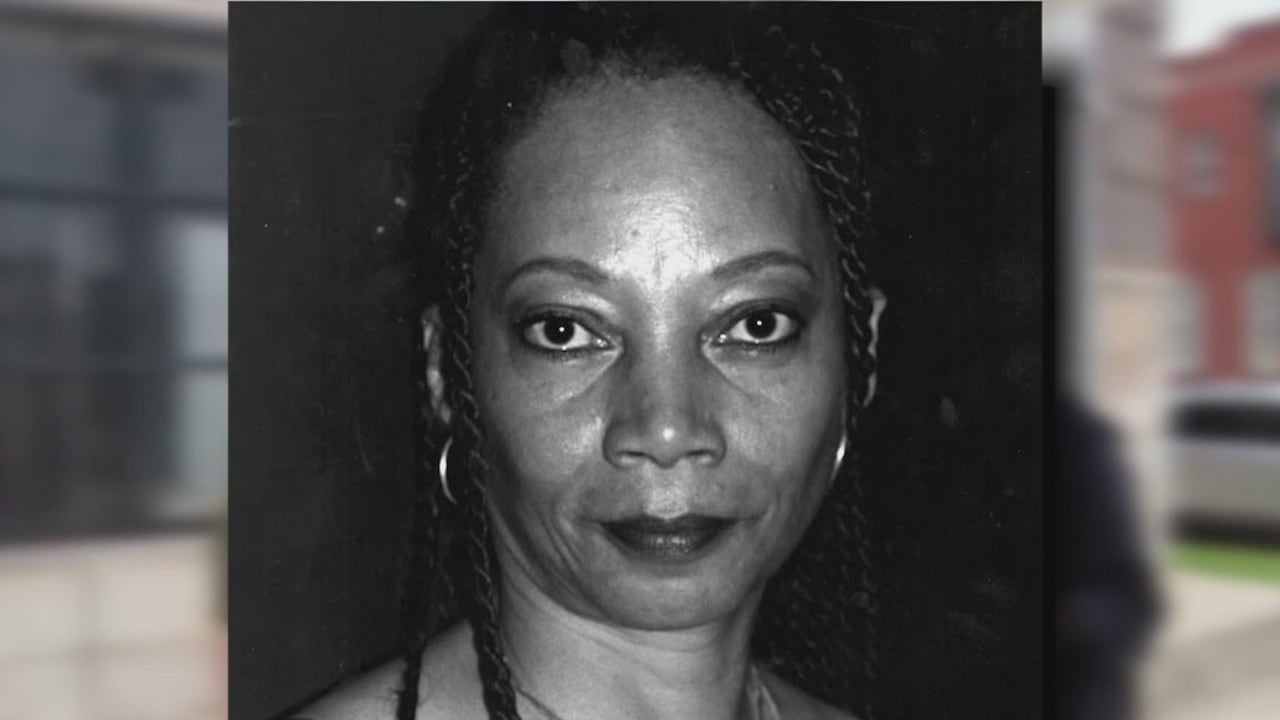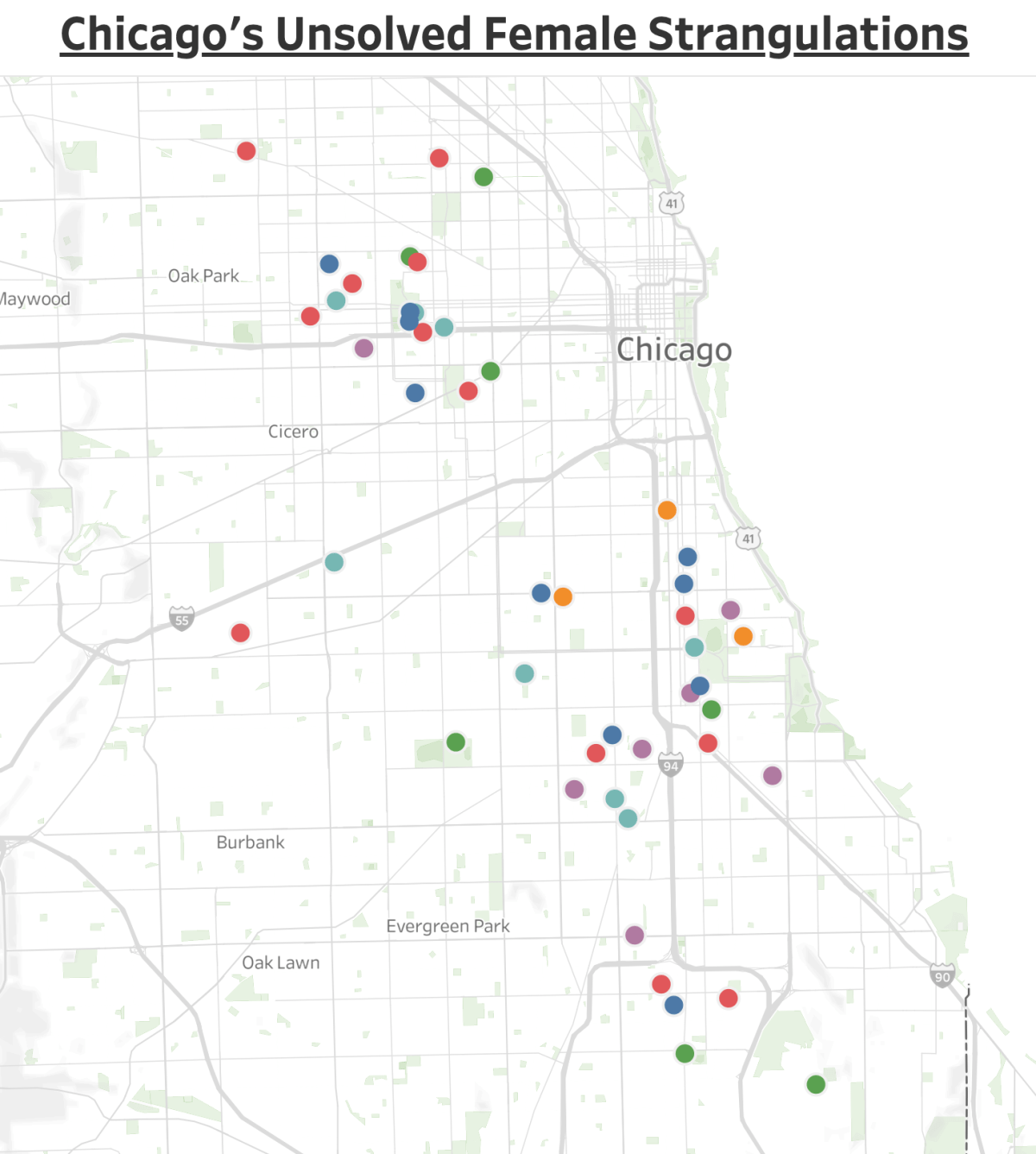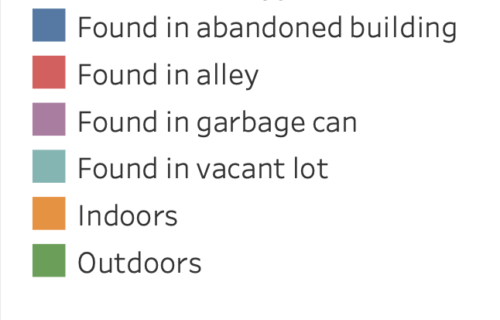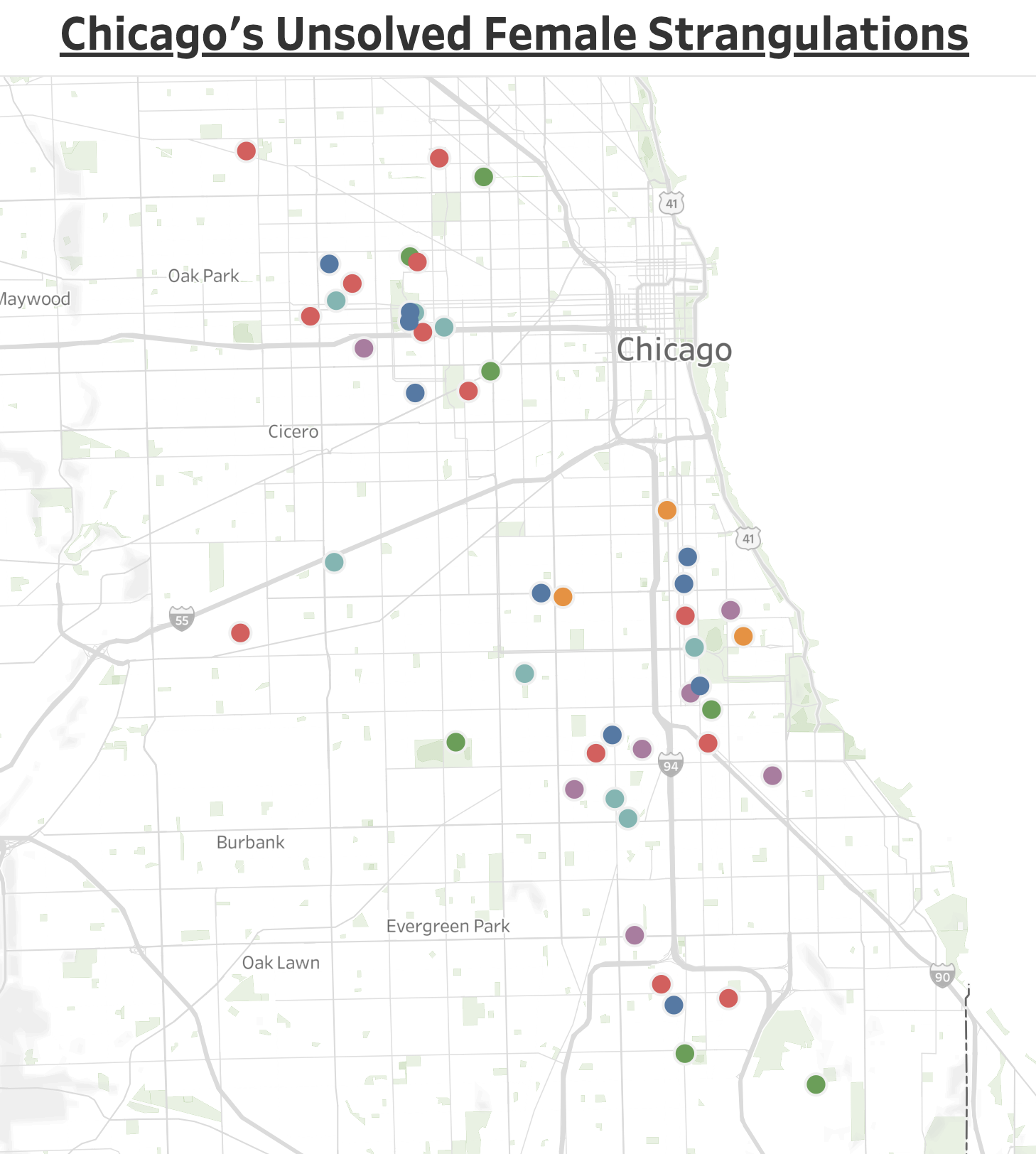YES! There is a serial killer on the loose.
Chicago Tribune
Chicago, Illinois
14 Jan 2018, Sun • Page 1-17
At least 75 women have been strangled or smothered since 2001 in Chicago. Arrests have been made in only a third of the cases, according to a first-ever analysis by the Tribune. (Case open Case closed ERIN HOOLEYCHICAGO TRIBUNE Catherine Saterfield-Buchanan, 58, was found strangled in June on the West Side. She struggled with learning disabilities and was arrested at least once for prostitution. PHIL VELASQUEZCHICAGO TRIBUNE Breon Smith stands near a vacant lot in the 7800 block of South Lowe Avenue in August where, in 2012, he discovered the strangled body of Pamela Wilson. Deaths, from Previous Page whereabouts. "You tellin' me they got away?" the relative said. "She was a nice, caring person." Staples, the chief of detectives, said investigative notes show detectives did interview a relative, though the family says it was a cousin who was not close to Saterfield-Buchanan. Massonburg said she doesn't recall talking to police about Saterfield-Buchanan, even though the shelter is known for helping women in the sex trade on the West Side. Massonburg believes police should regularly visit her shelter something they don't do now and get to know the women, build trust and maybe collect leads to solve some of the cases. "People know what's happening (on the street)," Massonburg said. "But they don't talk because they don't feel protected." 'Where were you?' The same unease can grip neighborhoods where the women have been discovered. In 2014, Velma Howard was found frozen in the snow in East Garfield Park. On the block where she was discovered, an elderly man recently answered his door, scrunched his face and jutted out his chin at the mention of the slaying. "Why are you here?" he barked. "Three years later? After all this time? Where were you?" He shook his head and slammed the door. His son, who lives in the apartment below him, came outside and talked to the reporters. Yes, he said, they remember when the body was found, buried in a snowbank. Official reports tell the story in vivid detail: Howard wore two white socks on her left foot, one on her right foot, and a metal hoop earring hung from her left earlobe. Black leggings were under her jeans, and a cigarette lighter and napkin were tucked into the left front pocket of her pants. Her fingernails were painted blue, and her toenails were red. With the temperature near freezing, she bundled herself in a blue sweatshirt and brown jacket. It wasn't until the snow was shoveled that her body was discovered wrapped in a tan blanket, tied together with a red rope. A white electrical cord was wrapped around her neck so tightly that purple bruising was visible. The son explained to a reporter why his dad was so upset: Neither he nor his dad was interviewed by police. "They just picked the body up and left," the son said. "We (are) just looked over." Neither man wanted to be named. The department would not allow die newspaper to see the files on Gomez, Saterfield-Buchanan, Howard or the other women because the cases are considered open and still active. But Staples said she personally reviewed 15 of the unsolved cases and referred three to cold-case detectives. Staples would not disclose which cases, saying she wanted to protect any new investigative work. 'They deserve the same' justice Staples sits in her fourth-floor office at Chicago police headquarters on the South Side, a 4-inch stack of case files to her left. She came up through the ranks of the detective division and has worked cases in neighborhoods where some of the women were found dead. They are tragic and tough cases to solve, she acknowledged. Like other murder cases, they are assigned to the regular rotation of homicide detectives in the city's three major investigative divisions. There are teams of specialists for sex-related crimes. As in any homicide, detectives canvass for witnesses, talk to family members and draw on help from the department's vice unit and its human trafficking team when investigating the cases. DNA and other evidence is collected and sent to the Illinois state crime lab. If a DNA profile is obtained, it is entered into a national database called CODIS. It contains samples from arrested felons as well as unnamed samples from victims and crime scenes. In that way, cases can be matched even when a suspect is not known. In the 51 unsolved cases found by the Tribune, no such case-to-case associations have been found, Staples said. And no cases have been linked by other investigative means. In the 1990s, Chicago police were caught off-guard when DNA analysis detected at least four patterns of sexual assaults and slayings of prostitutes in several South Side neighborhoods. The Tribune account in a 2000 story outlined the problem in terms strikingly similar to those of Gomez, Saterfield-Buchanan, Howard and the others: Most of the victims were strangled or suffered blunt-force trauma Many had arrests for drugs and prostitution and were engaged in what police at the time called a "high-risk lifestyle." A task force was created to investigate dozens of rapes and murders. It was staffed by about 10 detectives who could dedicate their time to tracking down witnesses and reviewing DNA results. Officials at the time pledged to stay vigilant and continue to use it when appropriate. "Years ago, nobody cared about these girls," Sgt. Tony Kuta said at the time. "Well, they're homicide victims. They're people, citizens of Chicago and they deserve the same investigation, the same integrity of investigation as anyone else." Staples and other department officials said they did not know what happened to the task force over the years. She doesn't think one is needed now, believing the nature of the crimes and the troubled backgrounds of the victims can be handled by detectives on regular duty. "It's all evidence and witnesses," she said. But some outside experts and law enforcement officials think a task force or other land of stepped-up effort is needed, both to watch for serial killers and to clear up the backlog of strangulations at a time when detectives are burdened by a spike in gang killings. There were 670 homicides in Chicago last year and 792 the year before, the most in nearly two decades, according to data kept by the Tribune. Many of those were fatal shootings involving gangs. "We are talking a lot about gun violence in the city of Chicago because we should, because we have a ridiculous amount of gun violence in this city," State's Attorney Foxx told the Tribune. Asked if a task force could help, Foxx said such collaboration between her office and police could increase clearance rates by focusing more attention on the cases and detecting possible patterns. She noted that her office already has staff members who specialize in human trafficking. "I think sometimes we forget that we can walk and chew gum at the same time," Foxx said. "There has to be sustained advocacy around women who are losing their lives because they are vulnerable."
Name Age Where she was found ( I apologize the list isn't more organized. It would not copy correctly because it was a graphic with list)
Joellyn McNerney 18 Inside a duffel bag in an alley Sherry aka Ladelle Handy 20 On a landing of an abandoned building Winifred Shines 33 In the back of a business Angela Ford 33 In the basement of an abandoned building Cynthia Halk 38 In a garbage can in an alley Ola Mae Wallace 39 In a doorway in an alley Saudia J. Banks 39 In a vacant apartment Bernadine Blunt 40 Inside a vacant building Elaine Boneta 41 On a sidewalk Charlotte Woods aka Day 42 In a vacant lot Diane G.Jordan 42 Next to a garbage can in an alley BrendaCowart 52 Outside DIED IN 2002 Name Age Where she was found Jody M. Grissom 19 Between two garbage cans in an alley Kyeko Drayton 22 At a waste dump Linda Ann Twine 28 At a disposal company near railroad tracks Dellie Jones 33 In a vacant garage Loraine Harris 36 In an alley Celeste Jackson 37 In an alley Lesia Evon Smith 39 In a gangway Bessie Scott aka Coleman 43 In an abandoned beauty salon Marcie A. Thome 44 In the bedroom of a rooming house, above a vacant storefront Judith A.Wilson 44 Near a garbage can in an alley Gwendolyn Williams 44 On a grassy area behind a store DIED IN 2003 Name Age Where she was found Rosenda Barocio 20 In an alley Latricia Hall 21 In a vacant lot Latonya Keeler 30 In a garbage can in an alley Terika Jones 30 On a basement floor of an abandoned building Ethel Jean Amerson 36 In an abandoned building Lucyset Thomas 38 On a garage floor Linda J. Green 42 In an alley Christine Ann Caponigro 42 In the back seat of a car behind a business Nancie Walker 55 In plastic bags on the side of road DIED IN 2004 Name Age Where she was found Makalavah Williams 18 Inside a laundry bag in an alley aka Shamika Bruce Tamala Edwards 37 Wrapped in a blanket in an alley Michele Davenport 40 In a garbage can in a vacant lot Sheryl M. Wilhite 41 In an abandoned lot Marcella Payton 41 Inside a garage Anna M. Calvin 42 In a garbage can in a backyard DIED IN 2005 Name Age Where she was found Precious J. Smith 23 Wrapped in a comforter in an alley Shaniqua Williamson 29 In a vacant lot Wanda Denise Hall 33 In a vacant lot Denise V. Torres 35 In an alley Yvette Mason 35 In an alley aka Mel inda Jackson Katherine Coleman 38 In a vacant lot DIED IN 2006 Name Age Where she was found Antoinette P. Simmons 21 In a garbage can Margaret Gomez 22 In a city of Chicago junk yard Kelly Sarff 34 In the basement of an abandoned building Rita French 45 In her bedroom DIED IN 2007 Name Age Where she was found Theresa Bunn 21 Inside a burning dumpster Jacqueline J. Berott 37 On the Bubbly Creek riverbank Veronica E. Williams aka Frazier 46 In an alley Hazel Marion Lewis 52 Inside a burning garbage can DIED IN 2008 Name Age Where she was found Genevieve N. Mellas 32 Near a lagoon in Marquette Park Eureka Jackson 38 In an abandoned house Linda Morgan 45 In a garbage can in an alley DIED IN 2009 Name Age Where she was found Jessica Rochelle Fon 25 Covered in a blanket in an alley Latoya A. Banks 29 In an alley Bree E. Gregory 29 In snow on the street Marcie Nichols 31 Behind a row of trees in LeClaire Park Vanessa Rojakovich 32 In the Chicago River Shannon Williams Morgan 38 In an alley Abbie Davis 43 In a closet of an abandoned building DIED IN 2010-17 Name Age Where she was found Leslie Brown 28 In an abandoned building Lutelda Michelle Hudson 29 In a stairwell Siobhan Hampton 30 In an abandoned building Bozena Staggs 36 In an alley QuandaCrider 37 In a closet of an abandoned house Lafonda Sue Wilson 43 In an alley aka Furda WestFonda West Angela Profit 46 In a vacant lot Pamela Wilson 30 In a vacant lot Denise Ayers 44 In an alley Amy Martinez 20 In a burning dumpster Velma Howard 50 In an alley Diamond Turner 21 In a garbage can in an alley Catherine Saterfield-Buchanan 58 On the street SOURCES: Chicago Police Department, Cook County medical examiner CHICAGO TRIBUNE






